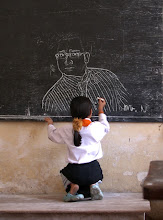
Facts on Visual Learners:
Visual-spatial learners are individuals who think in pictures rather than in words. They have a different brain organization than auditory-sequential learners. They learn better visually than auditorally. They learn all-at-once, and when the light bulb goes on, the learning is permanent. They do not learn from repetition and drill. They are whole-part learners who need to see the big picture first before they learn the details. They are non-sequential, which means that they do not learn in the step-by-step manner in which most teachers teach. They arrive at correct solutions without taking steps, so “show your work” may be impossible for them. They may have difficulty with easy tasks, but show amazing ability with difficult, complex tasks. They are systems thinkers who can orchestrate large amounts of information from different domains, but they often miss the details. They tend to be organizationally impaired and unconscious about time. They are often gifted creatively, technologically, mathematically or emotionally.You can tell you have one of these children by the endless amount of time they spend doing advanced puzzles, constructing with Legos, etc., completing mazes, counting everything, playing Tetris on the computer, playing chess, building with any materials at hand, designing scientific experiments, programming your computer, or taking everything in the house apart to see how it operates. They also are very creative, dramatic, artistic and musical.Here are the basic distinctions between the visual-spatial and auditory-sequential learner:
AUDITORY-SEQUENTIAL
VISUAL-SPATIAL
Thinks primarily in words
Thinks primarily in pictures
Has auditory strengths
Has visual strengths
Relates well to time
Relates well to space
Is a step-by-step learner
Is a whole-part learner
Learns by trial and error
Learns concepts all at once
Progresses sequentially from easy to difficult material
Learns complex concepts easily; struggles with easy skills
Is an analytical thinker
Is a good synthesizer
Attends well to details
Sees the big picture; may miss details
Follows oral directions well
Reads maps well
Does well at arithmetic
Is better at math reasoning than computation
Learns phonics easily
Learns whole words easily
Can sound out spelling words
Must visualize words to spell them
Can write quickly and neatly
Prefers keyboarding to writing
Is well-organized
Creates unique methods of organization
Can show steps of work easily
Arrives at correct solutions intuitively
Excels at rote memorization
Learns best by seeing relationships
Has good auditory short-term memory
Has good long-term visual memory
May need some repetition to reinforce learning
Learns concepts permanently; is turned off by drill and repetition
Learns well from instruction
Develops own methods of problem solving
Learns in spite of emotional reactions
Is very sensitive to teachers’ attitudes
Is comfortable with one right answer
Generates unusual solutions to problems
Develops fairly evenly
Develops quite asynchronously
Usually maintains high grades
May have very uneven grades
Enjoys algebra and chemistry
Enjoys geometry and physics
Learns languages in class
Masters other languages through immersion
Is academically talented
Is creatively, mechanically, emotionally, or technologically gifted
Is an early bloomer
Is a late bloomer
Visual-spatial learners are individuals who think in pictures rather than in words. They have a different brain organization than auditory-sequential learners. They learn better visually than auditorally. They learn all-at-once, and when the light bulb goes on, the learning is permanent. They do not learn from repetition and drill. They are whole-part learners who need to see the big picture first before they learn the details. They are non-sequential, which means that they do not learn in the step-by-step manner in which most teachers teach. They arrive at correct solutions without taking steps, so “show your work” may be impossible for them. They may have difficulty with easy tasks, but show amazing ability with difficult, complex tasks. They are systems thinkers who can orchestrate large amounts of information from different domains, but they often miss the details. They tend to be organizationally impaired and unconscious about time. They are often gifted creatively, technologically, mathematically or emotionally.You can tell you have one of these children by the endless amount of time they spend doing advanced puzzles, constructing with Legos, etc., completing mazes, counting everything, playing Tetris on the computer, playing chess, building with any materials at hand, designing scientific experiments, programming your computer, or taking everything in the house apart to see how it operates. They also are very creative, dramatic, artistic and musical.Here are the basic distinctions between the visual-spatial and auditory-sequential learner:
AUDITORY-SEQUENTIAL
VISUAL-SPATIAL
Thinks primarily in words
Thinks primarily in pictures
Has auditory strengths
Has visual strengths
Relates well to time
Relates well to space
Is a step-by-step learner
Is a whole-part learner
Learns by trial and error
Learns concepts all at once
Progresses sequentially from easy to difficult material
Learns complex concepts easily; struggles with easy skills
Is an analytical thinker
Is a good synthesizer
Attends well to details
Sees the big picture; may miss details
Follows oral directions well
Reads maps well
Does well at arithmetic
Is better at math reasoning than computation
Learns phonics easily
Learns whole words easily
Can sound out spelling words
Must visualize words to spell them
Can write quickly and neatly
Prefers keyboarding to writing
Is well-organized
Creates unique methods of organization
Can show steps of work easily
Arrives at correct solutions intuitively
Excels at rote memorization
Learns best by seeing relationships
Has good auditory short-term memory
Has good long-term visual memory
May need some repetition to reinforce learning
Learns concepts permanently; is turned off by drill and repetition
Learns well from instruction
Develops own methods of problem solving
Learns in spite of emotional reactions
Is very sensitive to teachers’ attitudes
Is comfortable with one right answer
Generates unusual solutions to problems
Develops fairly evenly
Develops quite asynchronously
Usually maintains high grades
May have very uneven grades
Enjoys algebra and chemistry
Enjoys geometry and physics
Learns languages in class
Masters other languages through immersion
Is academically talented
Is creatively, mechanically, emotionally, or technologically gifted
Is an early bloomer
Is a late bloomer

1 comment:
Sorry for the error in formatting.
Post a Comment